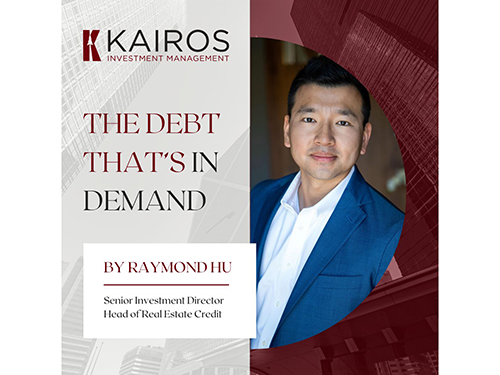Upcoming Bank Loan Maturities and The Role of Private Debt
Authored by Raymond Hu, Senior Investment Director – Head of Real Estate Credit May 2, 2023 Commercial real estate...

By Raymond Hu, Senior Investment Director – Head of Real Estate Credit
October 10, 2023
Not so long ago, near-zero interest rates and plenty of capital meant that traditional lenders—think larger national banks—were incentivized to offer debt to commercial real estate developments and investments. Thanks to this, the cost of capital was very low. This was the era of “cheap money.”
What a difference a few years make.
In normal markets, the so called “wall of maturities” can be accommodated by traditional financing methods. When lenders drop out of the market or tighten up lending standards, that “wall of maturities” creates a scarcity of capital.
That is exactly what is occurring:
It’s true that regional banks stepped in to take up some of that slack that the larger banks left behind during the COVID-19 pandemic. However, the market just lost three of the largest regional banks in the first half of 2023 which means both borrowers and depositors remain nervous about the current role of small and mid-size banks. The lack of liquidity from both large and regional banks has caused a credit crunch in the market.
With traditional lenders sitting on the sideline, what debt is currently in demand and available? The answer is that more real estate developers and investors are seeking shorter-term debt issued by private debt funds.
The Offerings
Traditional lenders issue loans based on in-house deposits, and they must maintain a certain amount of reserves as required by federal regulators. The fewer deposits, the less debt available. Private debt funds operate differently. They raise money from investors, then lend that money to real estate owners and developers with more flexibility and creative and customized structures. There’s no debt-to-capital ratio regulations and reserve requirements, as there are with traditional lenders. We believe through private debt funds, borrowers obtain liquidity, while investors can achieve healthy returns.
More of today’s commercial real estate borrowers are applying for bridge loans or mezzanine loans. These loan types are similar; in fact, a mezzanine loan is a type of bridge loan. While bridge loans are backed by property or other assets, mezzanine loans rely on a borrower’s equity as collateral.
These debt types offer the following benefits:
Shorter terms. Mezzanine and bridge loans are short-term, ranging from one to three years. After this, the borrower can refinance into a longer-term, lower-interest loan. In many cases, there are no prepayment penalties for early payoff. Additionally, interest on the loans is tax deductible. While there seems to always be a reason to borrow short or use bridge financing it is specifically in demand today. Given the current credit crunch it is logical that the demand for shorter term loans is higher than normal as owners only want to rely on this market until a healthier debt market exists.
More flexibility. Because private debt funds aren’t bound by the same federal and state regulations as their traditional lending counterparts, mezzanine or bridge funding can be tailored to a borrower’s specific situation and needs. Mezzanine and bridge loans also have shorter underwriting and approval periods, meaning a faster path to the liquidity provided by these loans.
The Forecast
The outlook on traditional lending for commercial real estate is murky. Billions in debt maturities are coming due. Meanwhile, inflation continues to impact cash flow and valuations, which means that traditional lenders face possible loan defaults.
Larger traditional lenders are continuing to circle the wagons. Even if the cost of borrowing were to decrease, the national and regional banks still implement stringent underwriting requirements for borrowers. They’ll also remain extremely selective when it comes to financing commercial real estate projects, and often limit proceeds, requiring additional capital from other sources to bridge the gap.
When encountering volatile periods like this, the real estate equity market is expected to take longer to adjust than the debt market. The debt market is moving more quickly and there will be many interesting opportunities for private debt funds which have the capital for deployment and are flexible investing across the capital stack. These lenders are also in the process of actively raising more money. We believe that these loans are proving to offer equity-like returns in a secured debt position to investors in today’s environment.
Because of their flexibility, less stringent requirements, and shorter-term commitments, it’s anticipated that the demand for bridge and mezzanine loans will continue. While the capital markets remain volatile and uncertain, these non-traditional lenders are in place to provide liquidity. This, in turn, will ensure ongoing investments in, and development of, commercial real estate projects.
For questions, contact investor relations at investorreporting@kimc.com or 949-800-8500.
 Back to All
Back to All
Authored by Raymond Hu, Senior Investment Director – Head of Real Estate Credit May 2, 2023 Commercial real estate...
Seeking Investment Stability During a Recession Authored by Trevor Schuesler, CFA, Associate Investment Director February 22, 2021 Since the...
By Raymond Hu, Senior Investment Director – Head of Real Estate Credit October 17, 2023 Just a few years...
Authored by Jonathan Needell, President and Chief Investment Officer November 4, 2021 Fannie Mae and Freddie Mac (the “Enterprises”)...
Authored by Jonathan Needell, President and Chief Investment Officer August 19, 2021 (reposted from LinkedIn article published on April...
Authored by Jonathan Needell, President and Chief Investment Officer December 15, 2021 The U.S. has entered a period of...
Look to Affordable Housing Authored by Jonathan Needell, President & Chief Investment Officer July 31, 2020 Since the pandemic...
Doing Well by Doing Good Authored by Trevor Schuesler, CFA, Associate Investment Director November 17, 2021 One of America’s...
18101 Von Karman, Suite 1100
Irvine, CA 92612
(949) 709-8888
(949) 800-8500
investorreporting@kimc.com
Copyright © 2024 Kairos Investment Management Company | Disclosures
Kairos Investment Management Company is an Equal Opportunity Employer and, as such, does not discriminate in employment on the basis of an applicant or employee’s race, ethnicity, ancestry, national origin, color, sex, pregnancy (or related medical conditions), childbirth, family status, gender, gender identity or gender expression, age, religion, marital status, sexual orientation, disability, medical condition, military or veteran status, reproductive health decision making, or any other protected classification or characteristic under applicable federal, state or local law. Kairos will not discriminate against an applicant or employee who has one or more protected classifications, is perceived or regarded as having one or more protected classifications, or is associated with someone who has one or more protected classifications.
Kairos Investment Management Company will also provide reasonable accommodations to applicants and employees who may need such accommodations in connection with employment with Kairos on the basis of their disability, religion, status as a victim of domestic violence or pregnancy. An applicant who needs an accommodation in order to pursue employment with Kairos should contact Human Resources at HR@KIMC.com to request such accommodations. Kairos will engage in a good faith interactive process with the applicant to explore accommodations that will be effective, reasonable and not create an undue hardship.
You can see how this popup was set up in our step-by-step guide: https://wppopupmaker.com/guides/auto-opening-announcement-popups/
You can see how this popup was set up in our step-by-step guide: https://wppopupmaker.com/guides/auto-opening-announcement-popups/